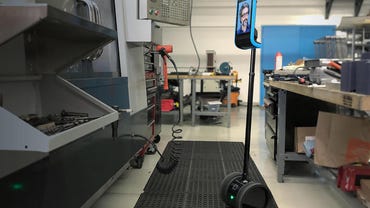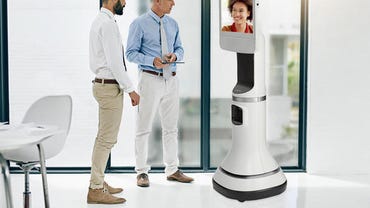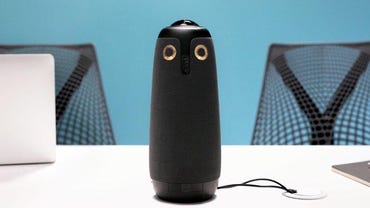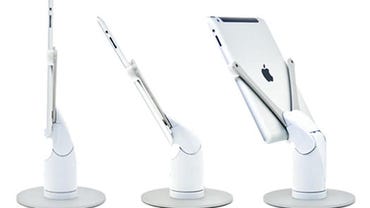Best telepresence robot 2022: Double 3, Ava, Meeting Owl, and more | ZDNet
How can remote workers make their presence known in their organization? How can enterprises overcome the limitations of video conferencing and enable a level of communication and collaboration that approaches on-site interaction?
Telepresence robots have been on the scene for the better part of a decade, though as global upheavals reshape work and reorient attitudes toward remote participation, the technology may finally be primed to break out of its niche user base and go mainstream. The timing is fortuitous: The market is now mature enough that consumers have choices when it comes to feature set and price point. As companies downsize physical locations and revamp their policies toward distributed workforces, telepresence offers both technological benefits and collaboration advantages that will appeal to some employers and workers alike.
The current telepresence lineup reflects the range of use cases and intended end-users out there, including a handful of models designed for specific fields and workflows, as well as others that fit organizations of any size. They were chosen based on a wide survey of this growing product category and by speaking with company representatives and end-users about their experience.
These are our picks for the best telepresence robots out there right now.
Ohmni Robot by OhmniLabs
Best budget telepresence
Sensors: 4K HD Wide angle camera; far field mic and speakers | Battery: 5+ hrs call-time | Size: 4’8″ tall; weighs 20 lbs | Features: Auto-docking; ultra-responsive tilting neck
In the battle for low-cost, truly robotic telepresence, OhmniLabs has been giving rival Double a major run for its money.
At under $2699, the Ohmni Robot weighs just 20 pounds and folds up, meaning you can take it anywhere, but still manages all the functionality you need in a telepresence robot. It features wide-angle, low-latency streaming at HD+ resolution and real-time full-resolution zoom to read whiteboards or see fine details at full UHD 4K detail.
A secondary dedicated wide-angle navigation camera lets you see around the base of Ohmni while you’re driving, which you can do remotely from just about any standard device. The unit features a bright 10.1-inch screen and integrated Jabra speakerphone for great audio. It doesn’t have automatic rising and lowering like Double, but the robot can move its head side to side for natural interactions.
OhmniLabs is also thoughtful about who might use the device, which has dual-band Wi-Fi radio with full 2.4GHz + 5GHz support and optimized background scanning and roaming for large spaces. Full 802.1x support means it should be simple to run on business or school networks.
Pros:
- Cost
- Size
- Neck articulation
Cons:
- Doesn’t automatically adjust height
Double 3 by Double Robotics
Best bang for your buck

Mics: 6 beamforcing microphones | Cameras: Two 13MP cameras | Battery: 4hrs (recharges in 2) | Height: 47″ – 60″
Where the Double 2 used a tablet display, Double 3 replaces the iPad with a fully integrated solution using an Nvidia Jetson TX2 GPU, two Intel RealSense depth sensors, two high-resolution cameras, and a beamforming microphone array. In place of the iPad is an integrated screen and new feature sets, including AR overlays, that really step up the functionality and feature set game of the Double.
Some of those features include a new click-to-drive interface, obstacle avoidance, and pan/tilt/zoom video, all of which contribute to a fully immersive remote experience that’s still intuitive to use. Perhaps the biggest functionality upgrade is the addition of mixed reality overlays.
In Double’s version of mixed reality, virtual 3D objects are added into the video stream to appear as if they’re in the real world. Virtual objects include helpful waypoints to make the video feed more informative during navigation.
The Double 3 with charging dock runs $4,499. If you already have a Double 2, you can upgrade your current device with a Double 3 head for $1,899.
Pros:
- Adjustable height to suit user
- Great sensors
- Easy to use
Cons:
Ava by Ava Robotics
Best telepresence for high-end corporate settings and hospitality

Video: HD video up to 1080p | Conferencing: Compatible with any standards-based videoconferencing infrastructure | Security: Embedded enterprise-grade security (including encryption, secure HTTPS management, password protection) | Control interface: iPad, iPhone, Web browser (Mac & PC)
With the Ava Telepresence robot, remote users easily and safely navigate through large workspaces, event spaces, and retail spaces with an enterprise-grade video conferencing system designed to make interacting with people on-site feel natural.
Unlike lower-priced models, the robot features intelligent, autonomous navigation. Remote users simply specify a destination, and Ava automatically moves to the desired location while avoiding obstacles. The technology is slick: The robot utilizes advanced mapping to learn the local environment and create a realistic map of the area, which enables it to navigate at the push of a button. Obstacle avoidance we’re used to seeing on autonomous mobile robots in fields like logistics and fulfillment enables Ava to navigate around people and avoid tumbles down the stairs.
Perhaps Ava’s biggest selling point is its form factor. This is one sleek unit, making it ideal for applications in client-facing offices and sectors like hospitality.
It’s also secure. Embedded enterprise-grade security (including encryption, secure HTTPS management, password protection) means Ava is well suited to a corporate IT infrastructure.
Pros:
- Autonomous
- Interfaces with multiple conferencing architectures
- Enterprise unit designed with salesforce and client interaction in mind
Cons:
- Pricey
- Overkill for many SMBs and smaller teams
Meeting Owl Pro 360 by Owl Labs
Best desktop video conferencing

Camera: Output Resolution: 1080p HD, Field of View: 360° | Mics: 8 omni-directional beamforming Smart Mics, Audio Pickup Radius: 18′ (5.5m) | Speaker: Three built-in speakers for 360° coverage and clear in-room sound | Processor: Qualcomm® Snapdragon™ 605 processor
Meeting Owl is a 360-degree video and audio conferencing system that automatically focuses on the people speaking in the room. It doesn’t move, so it’s not a robot by most definitions, but its autonomous functionality makes it an excellent and highly affordable tabletop system for individuals and teams that routinely conference and collaborate remotely.
Eleven-inches tall, Meeting Owl uses an eight microphone array to pick up sound and lock in on the person speaking. Remote viewers on the other end get a panoramic view of all the meeting attendants and a close-up view of the current speaker.
The system comes in original and Pro versions. The Pro version improves on the Meeting Owl’s 720p picture and increases audio pickup range from 12 feet to 18 feet, which is especially useful for larger teams or any collaboration utilizing a whiteboard.
The system integrates with all the major video conferencing services so usability is a snap. The Pro version goes for $999.
Pros:
- Superior to phone- and computer-based conferencing solutions
- Tracks users and dead simple to operate
Cons:
- Requires some setup
- May be overkill for those without some team members operating from shared location
Kubi Classic by Kubi
Best telepresence for education

Pan/Tilt: 300° Pan, +/- 45° Tilt | Tablet compatibility: Arms fit most tablets with 7-10 inch screens in portrait or landscape | Connectivity: Compatible with Apple and Android tablets with Bluetooth 4.0+
Kubi is an inexpensive ($600) robotic docking cradle for tablets that augments the teleconferencing experience you’re used to with the addition of movement.
During video conferencing, the remote participant can steer the cradle to look around a room. “Kubi” means “neck” in Japanese.
That makes it a particularly useful device for team environments where one participant is remote. The remote worker sits at a laptop or desktop but is able to look around the room to engage with speakers, which the device’s developers say enhances the interactive experience.
An enhanced audio kit and a secure docking retrofit to keep tablets secured to the base make them good options for educational environments where learners have to beam into larger classroom settings and engage in conversations but won’t necessarily have to move around the classroom.
Pros:
- Compatible with devices you probably have
- Inexpensive compared with other robots on this list
Cons:
- Questionable utility
- Pricey for a dock
How can I advocate for telepresence at work?
Offices are coming around to telepresence solutions for remote workers, and the recent health crisis has put the transition to distributed workforces into hyperdrive. Teachers and school administrators are now also embracing remote learning, which, in the short term, can quell infection rates — but, in the longterm, may be a way to maximize limited resources while bringing needed services to students.
Markets and Markets estimated the overall telepresence market will be over $300 million by 2023. However, that market research doesn’t take into account the rapid adoption of remote work due to COVID-19 or the expected long-term effects of the global stay-at-home experiment on attitudes toward remote working. Pivoting out of the pandemic, many companies may embrace a partially distributed workforce, which is a huge opportunity for developers of telepresence and video conferencing systems.
For workers, employers, and IT pros who wish to advocate for telepresence systems, the most important strategy is to tout the collaborative benefits of the technology and to have a plan for implementation. Robots in the workforce carry a longstanding stigma. Coupled with lingering resistance to remote work situations, existing biases on the part of employers or employees could stop the proposed adoption of telepresence dead in its tracks.
But advocating for telepresence as a way of maximizing collaboration and approximating the productive magic that happens in unstructured interactions in hallways and face-to-face chats can help mitigate concerns. As can explaining that most telepresence systems are ready-to-go out of the box with intuitive user interfaces. The technology is carefully designed not to need extensive training to use. After all, most humans don’t need training to have natural interactions in person.
What should I look for in a telepresence robot?
The biggest questions to ask are who might use a telepresence solution and in what settings. If you’re just looking to enhance video conferencing without spending big bucks or implementing new processes and protocols, solutions like Meeting Owl or Kubi would be the best places to start.
However, for those willing to embrace the dynamic features offered by a mobile robot, consider whether your environment is client-facing. A slick robot like Ava makes a great impression, although it comes at a price.
For most SMBs, models from Double or Ohmni are likely to be smart bets. They’re relatively inexpensive and provide a seamless user interface. A company can get by with one shared robot to start and easily scale up to meet needs.
After all, once one remote employee gets a robot doppelgänger, it’s likely others will want them as well.
|
Product |
Price |
Camera |
Battery |
|
Ohmni Robot |
$2,699 |
4K HD Wide angle camera |
5+ hours |
|
Double 3 |
$4,499 |
Two 13MP cameras |
4 hours |
|
Ava |
N/A |
HD video conferencing up to 1080p |
7 hours |
|
Meeting Owl Pro 360 |
$999 |
Output Resolution: 1080p HD, Field of View: 360° |
Plugs into computer |
|
Kubi Classic |
$600 |
Fits most tablets with 7-10 inch screens in portrait or landscape |
N/A |
How did we pick the robots on this list?
Our methodology comes from a mix of hands on reviews and detailed discussions with unbiased experts in productivity and workplace automation. We tried to take a broad sampling of the technologies available, and this list represents a mix of price points, use cases, and capabilities.
Are there other options to consider?
Here are some other products to look into:
For all the latest Technology News Click Here
For the latest news and updates, follow us on Google News.
